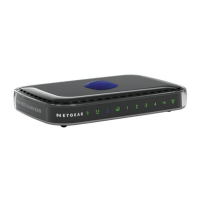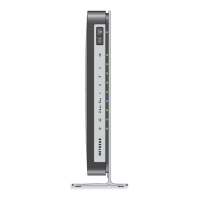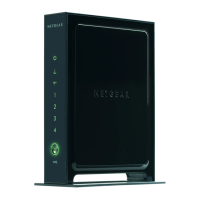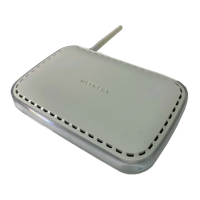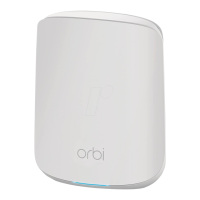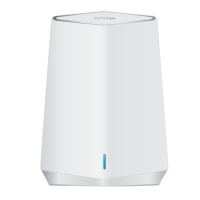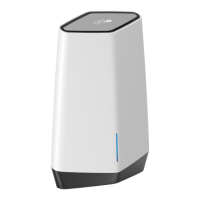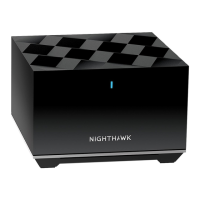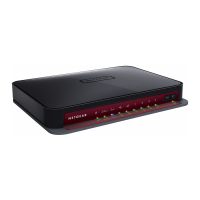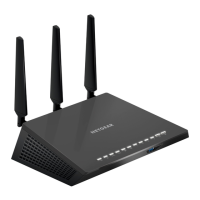
Do you have a question about the NETGEAR WNDR3800 and is the answer not in the manual?
| Brand | NETGEAR |
|---|---|
| Model | WNDR3800 |
| Category | Network Router |
| Language | English |
Details router's premium features like ReadySHARE, Video Mode, and ClearChannel Selector.
Enables access to shared files/printers on network, remote uploads, and printer sharing.
Optimizes streaming by recommending a separate 5 GHz Wi-Fi network for video.
Automatically scans for the clearest Wi-Fi channels to avoid interference and congestion.
Allows TiVo to access media files from a USB device connected to the router.
Lists the items included in the router's packaging and instructions for checking contents.
Instructions for physically setting up the router, including film removal and base alignment.
Describes the router's physical features, including front and back panels and labels.
Provides guidelines for optimal router placement to ensure best wireless signal range and performance.
Prepares for router setup by gathering ISP info and ensuring device settings are correct.
Explains different login types (router, ISP, wireless key) and their purposes for network access.
Guides users through router setup using the NETGEAR Genie web-based interface.
How to access and use NETGEAR Genie for managing router settings after initial setup.
Process for updating router firmware to the latest version via the Genie interface.
Overview of the router's main dashboard, showing internet, wireless, and device status.
Instructions for connecting wireless devices using manual or WPS methods.
Configure and view Internet Service Provider (ISP) settings for network connectivity.
View a list of all wired and wireless devices currently connected to the network.
Learn about and configure parental controls to filter objectionable content and manage access.
Manage and access USB storage devices connected to the router for network sharing.
View and configure basic wireless network settings like SSID, security, and channel.
Set up separate Wi-Fi networks for guests to provide Internet access without sharing main network security.
Walkthrough for initial router setup, detecting internet connection and configuring basic settings.
Facilitates adding WPS-capable devices to the network using push button or PIN methods.
Access various setup configurations including Internet, Wireless, Guest Network, WAN, and LAN.
Configure Wide Area Network (WAN) settings, including DMZ, MTU size, and NAT filtering.
Configure Local Area Network (LAN) settings, including IP address, subnet mask, and DHCP server.
Prioritize network traffic for specific applications, games, or devices for better performance.
Details requirements for USB drives, including speed standards and supported file systems.
Access shared USB storage contents on the network via Windows, Mac, or other methods.
Safely disconnect USB storage devices to prevent data loss or access issues.
Describes various use cases for sharing files and multimedia via USB storage.
Configure basic settings for USB storage, including network folder management.
Access USB storage content remotely over the Internet and invite others to share.
Share a USB printer connected to the router, allowing wireless access for printing.
Utility for controlling shared USB devices like printers or scanners connected to the router.
Configure advanced USB storage settings, including device name, workgroup, and access methods.
Configure the router as a DLNA/UPnP AV media server for devices like Xbox360 and Playstation.
Instructions on how to play router-stored media files on a TiVo device using ReadyDLNA.
Enhance security by configuring the router to only share designated USB devices.
Access the router's USB drive from remote computers using a web browser or FTP.
Block specific HTTP traffic by keywords or domain names for network security.
Block specific internet services or ports to prevent unauthorized access to network resources.
Configure schedules to block internet access for specific days and times.
Set up email alerts for security events, logs, and blocked site attempts.
Update the router's firmware to the latest version for improved performance and security.
Monitor the router's current status, including hardware, firmware, and network connection details.
Review logs of websites accessed or attempted, useful for monitoring network activity.
Back up, restore, or erase router configuration settings to manage its operational state.
Change the default router login password for administrative access to enhance security.
Configure router's USB storage for use with Mac's Time Machine backup software.
Configure advanced wireless settings like radio on/off, transmit power, and WPS.
Extend wireless network coverage by using the router as a wireless access point or repeater.
Manage inbound traffic exceptions for servers and applications using port forwarding or triggering.
Configure port forwarding to make local network servers (Web, FTP) accessible from the Internet.
Dynamically open inbound ports based on outbound traffic for applications needing specific ports.
Configure Dynamic DNS to access the router using a consistent domain name with changing IP addresses.
Configure static routes for advanced network configurations involving multiple routers or subnets.
Enable and configure remote access to manage the router's settings over the Internet.
Configure security settings for USB devices, allowing only approved devices to be shared.
Enable Universal Plug and Play (UPnP) for automatic device discovery and network configuration.
Configure IPv6 internet connection types if automatic detection by NETGEAR Genie fails.
Monitor and limit internet traffic volume per month or set traffic control rules.
Provides general tips and sequences for troubleshooting common router issues.
Diagnose router problems by observing the status and behavior of the front panel LEDs.
Troubleshoot issues preventing login to the router's interface, including IP address and credentials.
Resolve problems preventing internet access after the router is accessible, checking WAN IP and ISP settings.
Troubleshoot why router configuration changes are not being saved, often related to applying settings.
Address issues with incorrect router date or time, possibly related to NTP server synchronization.
Diagnose and resolve problems with wireless device connectivity, including signal strength and network settings.
Restore router to factory default settings, resetting user name, password, and network configuration.
Detailed technical specifications for the router, including hardware, protocols, and environmental ratings.
Information regarding regulatory compliance requirements for operating the product in different regions.
